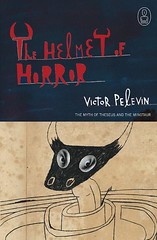Friday, March 10, 2006

Title: The Helmet Of Horror: The Myth of Theseus and the Minotaur
Author: Victor Pelevin
Publisher: Canongate
You wake in a room. You have no memory of how you got there. The room has the feeling of a hotel. There are two doors. One is wooden, opening onto a bathroom. The other is metal, there is an axe symbol, it is locked. On the wall there is a screen, which shows the Internet, a thread on the Guardian Unlimited site, the only thread, a thread started by someone called Ariadne.
I shall construct a labyrinth in which I can lose myself, together with anyone who tries to find me - who said this and about what?
Thus starts The Helmet Of Horror, the fourth book in the Myth Series published by Canongate. Reinterpreting the myth of Theseus and the Minotaur. A group of people find themselves alone in a room, their only contact with anyone else through the message board. So the novel unfolds through the transcript of the resulting conversations. Ariadne relates her dream to the group, an encounter with the minotaur - a giant with a strange brass helmet, the helmet of horror - accompanied by two dwarves. From this the group decide that the legend of Theseus is relevant. But what is going on? Is one of the group Theseus, is Theseus going to rescue them? Is one of the group the Minotaur, is the Minotaur going to kill them? Are any of these people even real, how can they tell - when all they are to each other is text on a screen.
As the novel unfolds the Russian novelist Victor Pelevin explores ideas of reality and of manipulation. He provides each of his characters with their own personal maze, their own personal puzzle. On the one hand explaining the concepts of virtual reality and the ways in which the programmer can manipulate the user, while on the other using these very same techniques to manipulate the characters. With these manipulations the characters explore their mazes, literal mazes from reality reconfigured into fiction, and in the labyrinths they each encounter variations of the minotaur and his dwarves. All along they are supplied with information about the helmet of horror through Ariadne's dreams, a strange device which generates everything from the past, including itself.
As a novel this is a post-modern narrative, the kind where essentially a group of characters sit around and talk the entire time. Yet it nips along, the text structure of dialogue transcribed having parallels with a play, except here everything is told in the conversation, as we have no visual accompaniment or stage direction. Thematically the nature of the labyrinth, the Minotaur and Theseus are central - it is variously suggested that we all create and live through our own maze, that the Minotaur is the beast within us, Theseus the human, and so on. But at the same time, on top of that we explore the themes of love, religion, politics, reality and many more over the course of the novel. The development between the characters is one of the things that keeps the novel moving along - Ariadne dreams, relating information for Monstradamus and Nutscracker to work out, UGLI 666 insists that everyone is a sinner and needs to repent, Organizm (-; flirts with users as soon as he finds out they are female, while the relation between IsoldA and Romeo-y-Cohiba seem to form an intense attraction from the start. The characters flirt, fight and share, but the end unites them, as the truth is revealed. Though in terms of revelations, I suspect that I'll be needing to go back over it again before it entirely makes sense.
Comments:
Post a Comment
 this is the voice of re:mote induction.
this is the voice of re:mote induction.